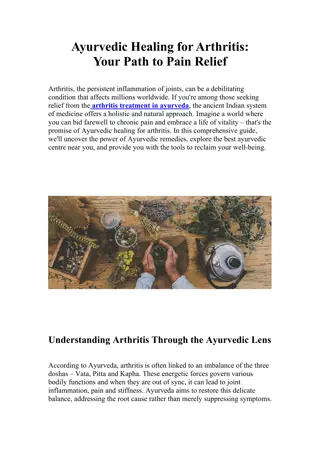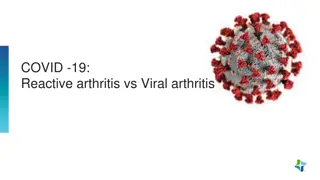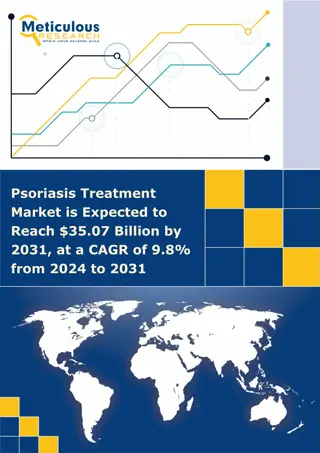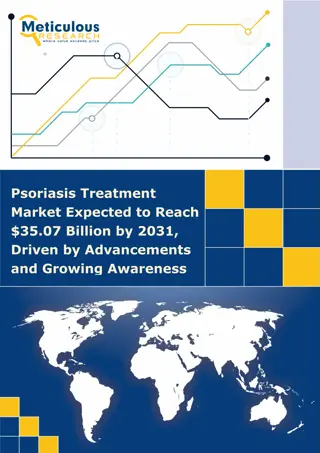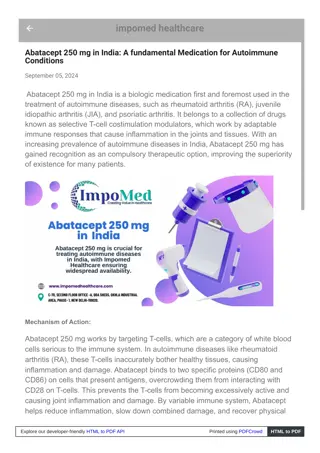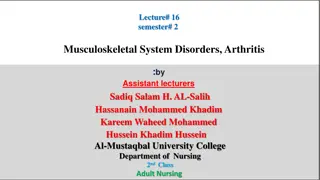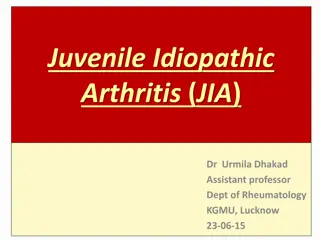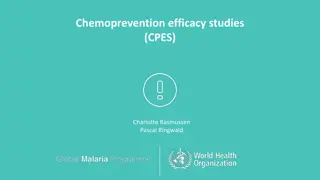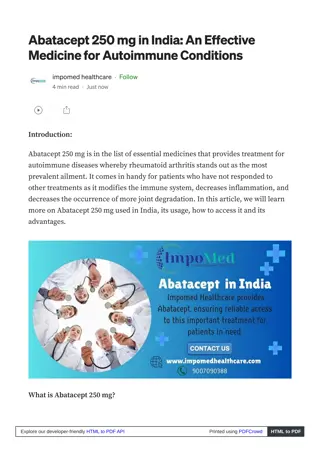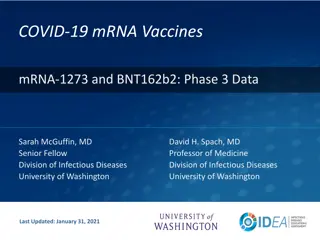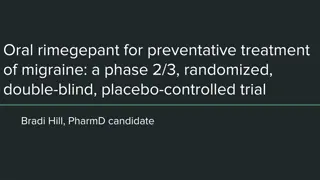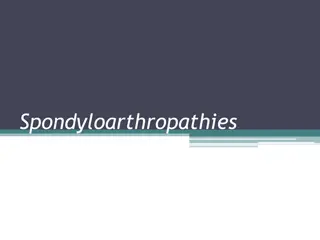Efficacy and Safety of Guselkumab in Phase 3 Study for Psoriatic Arthritis
This study evaluates the efficacy and safety of Guselkumab, a monoclonal antibody targeting the P19-subunit of Interleukin-23, in biologic-naive patients with active Psoriatic Arthritis. Through 52 weeks, the randomized, double-blind, placebo-controlled trial provides valuable insights into the treatment of Psoriatic Arthritis. Findings from this study shed light on the potential of Guselkumab in managing this condition.
Download Presentation

Please find below an Image/Link to download the presentation.
The content on the website is provided AS IS for your information and personal use only. It may not be sold, licensed, or shared on other websites without obtaining consent from the author.If you encounter any issues during the download, it is possible that the publisher has removed the file from their server.
You are allowed to download the files provided on this website for personal or commercial use, subject to the condition that they are used lawfully. All files are the property of their respective owners.
The content on the website is provided AS IS for your information and personal use only. It may not be sold, licensed, or shared on other websites without obtaining consent from the author.
E N D
Presentation Transcript
Efficacy and Safety of Guselkumab, A Monoclonal Antibody Specific to the P19-subunit of Interleukin- 23, Through Week 52 of a Phase 3 Randomized, Double-blind, Placebo-controlled Study Conducted in Biologic-na ve Patients with Active Psoriatic Arthritis McInnes I, et al. Efficacy and Safety of Guselkumab, a Monoclonal Antibody Specific to the p19-Subunit of Interleukin-23, Through Week 52 of a Phase 3, Randomized, Double-blind, Placebo-controlled Study Conducted in Biologic-na ve Patients with Active Psoriatic Arthritis - ACR Meeting Abstracts (acrabstracts.org)
Study Design and Methods Adults with biologic-na ve psoriatic arthritis who had: 5 swollen joints 5 tender joints C-reactive protein level 0.6 mg/dL Patients were randomized (1:1:1) to: Guselkumab 100 mg administered every 4 weeks Guselkumab 100 mg administered at weeks 0 and 4, and then every 8 weeks Placebo At week 24, patients who had been randomized to placebo were switched to guselkumab 100 mg administered every 4 weeks American College of Rheumatology (ACR) response rates at week 52 were based on non-responder imputation (NRI) for missing data and as observed in patients who continued study agent at week 24 Data for additional endpoints were collected at week 0, week 24, week 52, or at time of treatment discontinuation
Results Summary 739 patients were randomized and treated 712 (96.3%) continued study treatment through week 24 689 (93.2%) completed study treatment through week 52 NRI ACR20 response rates continued to increase after week 24 At week 52, the ACR20 response rates were: Guselkumab administered every 4 weeks: 70.6% Guselkumab administered every 8 weeks: 74.6% Response patterns for ACR50 and ACR70 were similar At week 28, the NRI ACR70 response rates were: Guselkumab every 4 weeks: 20.2% Guselkumab every 8 weeks: 20.0% At week 52, the NRI ACR70 response rates were: Guselkumab every 4 weeks: 26.1% Guselkumab every 8 weeks: 27.8%
Results Summary (cont) Similar patterns of response were observed in both guselkumab groups for: Psoriasis Activity and Severity Index responses minimum disease activity/very low disease activity responses dactylitis and enthesitis resolution mean improvements in Health Assessment Questionnaire Disability Index mean improvements in Short Form-36 Physical Component Summary and Mental Component Summary scores Similar findings were generally observed for the group of patients who were randomized to placebo and then switched to guselkumab administered every 4 weeks at week 24, although the observed ACR20, ACR50, and ACR70 response rates were slightly lower at 52 weeks in this group than in the 2 groups initially randomized to guselkumab
Results Summary (cont) Radiographic progression was similar in the guselkumab every 4 weeks group from week 24 through 52 compared with week 0 through 24. In contrast, less radiographic progression occurred from week 24 through 52 compared with week 0 through 24, in both the guselkumab every 8 weeks group and the group switched from placebo to guselkumab at week 24 With respect to safety, A serious adverse event occurred in 4.2% of the patients treated with guselkumab 1.2% experienced a serious infection No patients died, had inflammatory bowel disease, an opportunistic infection, active tuberculosis, or anaphylactic or serum sickness-like reaction
Faculty Commentary Guselkumab 100 milligrams given at weeks zero and four, and then every eight weeks, has similar clinical, functional, and radiographic efficacy as guselkumab 100 milligrams given weekly. Similar improvements were observed in multiple domains of psoriatic arthritis in patients not previously treated with the biologic. Clinical responses appear to be durable over one year with maintained safety.
Implications for Clinical Practice Approval of guselkumab for PsA adds to the growing list of approved medications. Where guselkumab will fall within our current therapeutic armamentarium is unclear. Will depend upon patient access, as well as physician and patient preferences considering the domains of psoriatic arthritis involved, the route and frequency of administration, and patient and physician comfort with the molecule. Guselkumab appears to be very effective for skin manifestations and reasonable for joint manifestations.
Ustekinumab-treated Patients with Psoriatic Arthritis in a Real-world Study: Similar Clinical Responses and Treatment Persistence over One Year in Elderly and Younger Patients Gossec L, et al. Ustekinumab-Treated Patients with Psoriatic Arthritis in a Real-world Study: Similar Clinical Responses and Treatment Persistence over One Year in Elderly and Younger Patients - ACR Meeting Abstracts (acrabstracts.org)
Study Design and Methods Post hoc analysis of a multinational, prospective, observational study in patients with psoriatic arthritis prescribed either ustekinumab or a tumor necrosis factor inhibitor as first-, second-, or third-line treatment The effectiveness and safety of ustekinumab were compared by age group, ie, age <60 years vs age 60 years Effectiveness was assessed using a variety of validated measures such as: Swollen 66-joint Count Tender 68-joint Count Health Assessment Questionnaire- Disease Index Patient s Pain Assessment Patients were followed over 15 months
Results Summary Entire cohort (N=930) 458 were treated with ustekinumab 77.1% were age <60 years Baseline demographics were similar in the 2 age groups except that patients age 60 years had: Higher incidence of cardiovascular disease (79.4% vs 30.7%) Greater duration of psoriatic arthritis (9.54 vs 6.88 years)
Results Summary (cont) Using the variety of validated measures previously mentioned, effectiveness after treatment with ustekinumab for 6 months and 1 year was generally comparable in the two groups The incidence of adverse events, but not withdrawal due to an adverse event, was somewhat higher in the older group Treatment persistence did not differ between patients age <60 years vs age 60 years Rate for stop/switch within first year was 15% higher in patients age 60 years vs age <60 years (P=NS)
Faculty Commentary Ustekinumab was clinically effective in both younger and older patients. Older patients are more likely to have adverse events, for numerous reasons. Nonetheless, the adverse event profile of ustekinumab did not cause the older patients to withdraw treatment. Approximately three-quarters of patients in both age groups maintained ustekinumab for over one year.
Implications for Clinical Practice Ustekinumab can be used in older patients with the same degree of confidence as a younger patient. With the proliferation of treatments now and in the future for psoriatic arthritis, including oral therapies, ustekinumab will remain a part of the therapeutic armamentarium, but where it will be utilized is hard to predict.
Impact of Upadacitinib on Reducing Pain in Patients with Active Psoriatic Arthritis: Results from Two Phase 3 Trials in Patients with Inadequate Response to Non-biologic or Biologic DMARDS McInnes I, et al. Impact of Upadacitinib on Reducing Pain in Patients with Active Psoriatic Arthritis: Results from Two Phase 3 Trials in Patients with Inadequate Response to Non-biologic or Biologic DMARDs - ACR Meeting Abstracts (acrabstracts.org)
Study Design and Methods Adults with active PsA were enrolled in either the SELECT-PsA 1 or SELECT-PsA 2 study Patients in SELECT-PsA 1: inadequate response or intolerance to treatment with 1 non-biologic DMARD Patients in SELECT-PsA 2: inadequate response or intolerance to treatment with 1 biologic DMARD Patients were allowed concomitant treatment with 0, 1, or 2 non-biologic DMARDs Patients were randomized to once-daily treatment with: Upadacitinib 15 mg Upadacitinib 30 mg Placebo SELECT-PsA 1 included a fourth treatment arm of adalimumab 40 mg every other week Treatment was continued for 24 weeks
Results Summary Patients randomized: SELECT-PsA 1: N=1704 SELECT-PsA 2: N=641 In both studies, a significantly higher proportion of patients receiving upadacitinib 15 mg or 30 mg achieved improvements in most pain endpoints compared with patients receiving placebo In patients treated with upadacitinib, Improvements in most pain endpoints occurred as early as week 2 and were either sustained or increased through week 24
Results Summary (cont) Change from baseline in Physicians Global Assessment of pain Numerical Rating Scale scores over time were significantly greater with upadacitinib compared with placebo At week 24 in SELECT-PsA2, a 70% or greater reduction in pain was experienced by: Upadacitinib 15 mg: 22% Upadacitinib 30 mg: 27% Placebo: 3% Improvements in the spinal pain and joint pain/swelling as assessed by the Bath Ankylosing Spondylitis Disease Activity Index were significantly greater in the upadacitinib groups
Results Summary (cont) In the SELECT-PsA 1 trial: Significantly higher proportions of patients receiving upadacitinib 30 mg vs adalimumab 40 mg achieved improvements in most pain assessments as early as week 2, which were sustained through week 24 At week 24, a 70% or greater reduction in pain was experienced by: Upadacitinib 15 mg: 31% Upadacitinib 30 mg: 34% Adalimumab 40 mg: 25% Improvements in several assessments were also significantly greater with upadacitinib 15 mg compared with adalimumab 40 mg.
Faculty Commentary Upadacitinib 15 milligrams appears to be efficacious in the treatment of pain in patients with PsA. Efficacy generally comparable to adalimumab with respect to speed of response and depth of response. Results for speed and depth of response are similar in conventional synthetic DMARD and biologic DMARD incomplete responders.
Implications for Clinical Practice These results are not clinically relevant since upadacitinib is not yet approved in PsA. The results of the SELECT-PsA studies were both very positive, and one would expect that upadacitinib will be approved in PsA. If approved, upadacitinib is attractive as an oral medication, which can be very effective after conventional synthetic DMARDs, probably more effective than apremilast, and possibly more effective than tofacitinib. Upadacitinib will still require lab monitoring. It is unclear if upadacitinib will replace TNF inhibitors and how it will compete with IL-17, IL-23 molecules.



